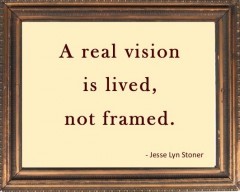 Does your team share a real vision? Is it being lived? Does it make a difference?
Does your team share a real vision? Is it being lived? Does it make a difference?
Answer these 10 questions to find out how effective your vision is.
Get a reality check. Ask everyone on your team to rate the vision and discuss your answers. It’s a non-threatening way to launch a powerful team discussion.
(There’s a link to a free online version of this assessment at the bottom of this article.)
Directions
Rate each of the questions below on a 1 – 5 scale. Then total your responses to get your Score.
Next read the section “What Your Score Means” to understand your Score and get ideas to help your team.
Rating Scale
- = Rarely
- = Occasionally
- = Sometimes
- = Usually
- = Almost always
Team Vision Questions
1. Does everyone on your team share the same vision?
2. Are team members excited, inspired and motivated?
3. Does everyone understand and agree on your team’s purpose?
4. Can you see the picture of what success looks like?
5. Do you have stated values that guide decisions?
6. Do you hold each other accountable for behaving consistently with the team’s values?
7. Does your vision help you identify priorities?
8. How often do team members discuss the big picture and how daily activities support your vision?
9. How often do you track where you are in relation to your vision and change course if needed?
10. Can each person see how they contribute to achieving the vision?
Get Your Score
Total your answers for each of the questions to get your Score
What Your Score Means
Score 45 – 50 = MOBILIZED
You have created a compelling vision that is energizing, provides focus and sets direction. You are clear about where you are going and what values guide your journey. Check it out and make sure others are as clear and as excited as you think they are.
Score 39 – 44 = FORMING
You have the beginnings of a powerful vision but there is more work to be done. You need more clarity, more excitement and/or engagement of others. Keep working on getting people aligned around the vision and you will see an energized and focused workforce emerge.
Score 30 – 38 = TYPICAL
You live in a typical organization. Some people may be clear about where they are going, but there is no shared sense of direction. Although you may be accomplishing work, there is a lot of wasted effort. Work often needs to be redone because leaders change their minds or were not clear in their communications in the first place. People are juggling multiple concerns and trying to “do it all” because priorities are not clear.
Score 29 or less = UNFOCUSED
If work is getting done, ask “at what cost?” You and your people are in danger of “burning out.” Individuals may care deeply, but there is no collective mindset or vision to align them around something greater than their daily tasks.
How do others on your team rate your team?
The real power comes when everyone on your team answers these questions and you discuss your responses.
- What are the similarities and differences?
- Where do you need more clarity or agreement?
- What is one thing you can each do that will improve your team’s score?
It’s not an excuse to say, “My company doesn’t have a vision, so my team can’t have one.” Vision can start anywhere in an organization. Focus on your own sphere of influence. This is where you have the greatest opportunity to create a shared vision.
Free Online Version of the Assessment
Click on the picture below to access the free online version.














Thanks Jesse. This is a great tool to use to analyze the integrity of the vision. The questions also say a lot about the culture of the team. When I work with teams, we periodically go over the team agreements so the team members can assess their own behavior. This will be a great tool to use at those times as well.
Hi Marcia, Yes, it’s helpful for looking at the integrity of the vision, especially before publishing it or using it as a springboard for strategic planning. It’s also helpful for getting a reality check. Often I find one person is clear about the vision, but doesn’t realize the rest of the team as not aligned. This gives people a non-judgmental way to open the discussion.
Excellent point about it also surfacing information about the culture. Thanks so much for sharing your thoughts, Marcia. Delighted to see you here!
Hi Jesse,
Awesome post as always! When I was in residence – yes leadership studies have residencies lol – we spent considerable time on team building and as you point out, having an agreed upon set of values and a team vision were paramount. We also had a cool little one page team check in and assessment instrument that we were encouraged to use after each team meeting. When I find it I’ll post it somewhere.
I’m curious about the “My company doesn’t have a vision, so my team can’t have one.” excuse. Do you find that it can be a bit of a challenge, not so much if the organization doesn’t have a vision, but rather the struggle occurs when the vision of the org is not clear enough and teams try to guess how they can be in alignment with the organization’s direction?
Or worse yet, when the stated values, vision, purpose/mission are not being lived by the organization – they are espoused but not genuine – and the team tries to align with the espoused version?
Sorry, messy questions that make for good dialogue but have no clear resolution lol. This is something I have run into a few times and it has most ended badly for the team. Just wondering what your thoughts are on this.
jamie
All good thoughts and questions, and real problems for teams in organizations that are floundering. I have observed the same problems you describe, Jamie. These are messy problems because organizations are messy and so the problems are as well. Things are only nice and tidy in theory. It ends badly when the team leader does not protect the boundaries around their team. However, I have also observed that a respected, confident team leader can protect his or her team by serving as a buffer between the team and negative fall out and distractions from on high and enable the team to stay highly focused and to deliver on their vision. I have also observed that sometimes the team shines so brightly that it affects other areas of the business and contagion occurs. Other teams begin to get clear about what business they are really in, what values are needed to guide them and what it will look like when they are fulfilling their purpose. In other words they create a vision as well. And it begins to spread upward and outward. Organizational vision is not always delivered from on-high.
Thanks for your thought-provoking comments, Jamie.
Jesse, what a brilliant yet elegantly simple tool to help a team look at their “vision”. I have one small point about “holding others accountable”. I am beginning to rethink that term “hold accountable”. It reminds me of a parent looking over a kid’s shoulder. It does not suggest self-empowerment but rather over-powering. If members are excited, motivated, and inspired they will hold themselves accountable. Does that make sense?
As always, I find your work stimulating. Thanks
Good point, Eileen. I’ve been thinking about that also lately. I think I need to relook at my language. The point I want to highlight is that it’s problematic when people don’t speak up when norms or agreements are not upheld.
Hello Jesse,
These are great questions. Thanks for making us think. One of the problems I have found with many well meaning business owners is that they will answer “Yes” to all of these questions in the belief that they are doing things right. Their employees , however, would see it very differently.
Would they be better as essay questions so that we have to articulate the answers. Would the insight be deeper? For example rather than “Does your vision help you identify priorities?” it could be “What priorities does your vision help your team identify?”
I hope you post the outcome of your survey. Best wishes, Ruth
Hi Ruth,
Interestingly over 500 people have answered these questions and most rate their team’s vision as in the “typical” range. I suspect that is the case because, as you point out, they are employees and not the business owners. As I mention in my post, the best use of this questionnaire is as the basis of a team discussion. It’s always best to get other’s perceptions and not reply solely on your own. The purpose of the questionnaire is to help people determine whether they need to do more work on their vision. If you score 38 or less, I think it would be helpful to read Full Steam Ahead: Unleash the Power of Vision (co-authored with Ken Blanchard) to understand the elements of a compelling vision and how to engage others in creating a shared vision.
Really nice post, Jesse. One of my favorite things in here is:
Thanks, Steve.